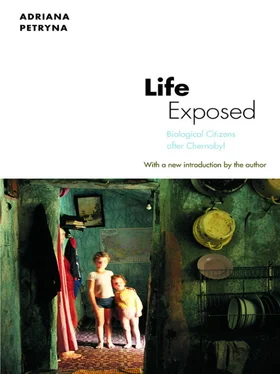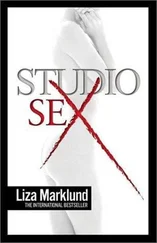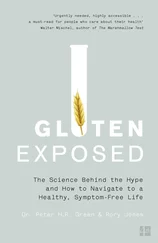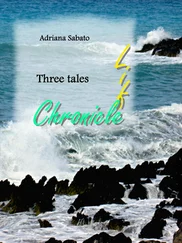Payments-in-kind such as these have increased and are a supplement to unpaid salaries.
In fact, compensation to victims of the atomic bombs in Hiroshima and Nagasaki were not paid out in onetime payments. As in the Chernobyl case, authorities required victims to undergo some form of clinical monitoring in order to be eligible for compensations. See Hiroshima and Nagasaki 1981. For a history of the role of American science in accounting for the medical effects of the atomic bombings, see Lindee 1994.
Current laws guarantee that additional pensions on the basis of a Chernobyl-related disability cannot be lower, per month, than:
182.82 hryvni ($90)—for level one disability
145.43 hryvni ($72)—for level two disability
108.03 hryvni ($54)—for level three disability
Approximately half of the Chernobyl disabled obtain 100-200 hryvni (or $50-100).
Benedicte Ingstad and Susan Reynolds Whyte (1995) have shown how disability is as much a product of social definitions and restrictions and opportunities of access as it is a physical or functional limitation or disease.
He transported contaminated building materials from the reactor to burial pits ( mohyl’nyky ) scattered throughout the Exclusion Zone.
From the perspective of one medical examiner I interviewed, Chernobyl deaths “look like any other deaths.” Kyiv City Morgue, November 1996.
The incidence of alcoholism in Ukraine was second-highest among all republics in the former Soviet Union; it was 136.4 per 100,000 in 1990.
He also abolished state requirements imposed on enterprises to make contributions to the fund.
“President Governs by Decree,” Ukrainian Weekly, July 6, 1998, 1.
The half-life is the time it takes for half of an original amount of radiation to decay. Following the first half-life period, one-half of the original quantity remains. After the subsequent half-life period, one-quarter of the original quantity remains, and so forth, until no radiation is left.
For an anthropological account of scientific measures as they figure costs, see Petryna 1998.
For a historical look at the importance of the role of complaint mechanisms and denunciation practices in Soviet society, see Fitzpatrick 1999.
Because “there is no specific illness for radiation,” its clinical pathological course is considered highly “individual,” according to the view of many scientists, including Roman Protas, Kyiv-Mohyla Academy, Kyiv.
See also Michel Foucault’s reflections on Lysenkoism as a starting point for his reflections on power and knowledge in Western psychiatry, in the essay “Truth and Power” (in Foucault 1984).
0.01 rem represents the allowable threshold dose, in this case, specifically for the nervous system.
To this day, Rita has no witnesses testifying to her even having been at the Chernobyl plant at the time of the explosion.
Their numbers are broken down according to age: to 1 year of age—6 persons; to 3 years—5 persons; to 7 years—12 persons; to 14 years—19 persons; to 20 years—18 persons; 21-30 years—110 persons; 31-40 years—115 persons; 41-50 years—110 persons; 51-60 years-24 persons; 60+ years—8 persons.
Among the cases studied, 118 were found to have no relevance to the questions; the majority of individuals were considered to be experiencing acute radiation effects and exhibiting symptoms associated with radiation-induced damage; 9 had contracted ARS. The first reported indications of ARS were nausea, vomiting, and weakness, followed by typical manifestations of ARS (changes in the blood—leukopenia, lymphopenia, thrombocytenia, hemorrhagic syndrome, hair loss, and an asthenic disposition).
Some of these 148 displayed high blood pressure and gastrointestinal pains; 11 had skin lesions. Health disorders lasted up to 21 days or less. Some experienced disorders for 17 days, and in some the disorders lasted no more than 6 days.
He retired from this position in 2000.
See also “Index of Illnesses through Which a Connection with Ionizing Radiation and Other Negative Factors Can Be Established in the Adult Population Which Suffered as a Result of the Chernobyl Nuclear Disaster,” Ukrainian Ministry of Health, 1996.
“The diagnosis of [these] disorders is to be registered by the neuropathologist after a detailed review of the state of health, the results of the electroencephalogram, rheoencephalogram, echocardiogram, computerized tomographic scan, roentgenography, consultation with the opthalmalogist and the psychologist” ( Chornobyl’ska Katastrofa 1995:459).
A. P. Kartish, a neuropathologist, reorganized the work and nosographic criteria by which the new Chernobyl medical-labor committees operated in the context of a keynote address at the eighth congress of neuropathologists, psychiatrists, and narcologists in Kharkiv in 1991. See also Bobileva 1994b.
In fact, she complained of leg pains, which she said the doctors would not treat.
Lev continued with his litany, reiterating familiar themes: “We didn’t know anything. The first of May, everyone went to the streets for the demonstrations, there was an international bike race. In general it was kept quiet. Nobody said anything to anyone. They said everything was fine. The minister of health was on TV, Romanenko. He said there was no trouble, nothing terrible happened, not to worry. But the officials got their children out on the 26th of April, over the border. And you people, you die here. The Communist Party had that tendency, just for itself and the people are of no concern.” Psychoneurological Hospital, March 1996, Kyiv.
Patient hunger strikes continued to occur, particularly in clinics in the Kharkiv area, where many coal miners had been recruited for Chernobyl work.
There were a great many of these meat items available on the streets, and people were stumped by the fact that these “tasteless” processed foods were in fact cheaper and becoming more abundant than domestically raised meats—more signs of national economic stagnation.
In Kyiv, some grave diggers reportedly began to charge more than five hundred dollars to bury a corpse, a fee considered astronomical by Ukrainian standards. Where autopsies had once been routine, they were now carried out only in extreme situations (for example, to ascertain cause of a wrongful death, such as homicide). Even the reporting of death was bureaucratically backlogged. While I was examining these statistics, the head statistician at the Ministry of Statistics asked me, rhetorically, “What’s normal, anyway?”
State statistics provide a profile of the transition’s human toll. Source: Demohrafichnyi Istochnyk Naselennia Ukrainy 1994.
 Читать дальше
Читать дальше













